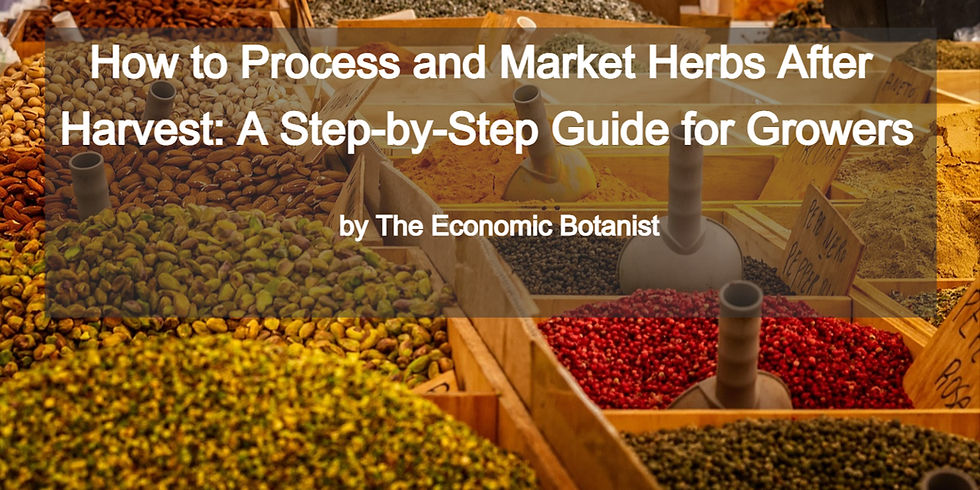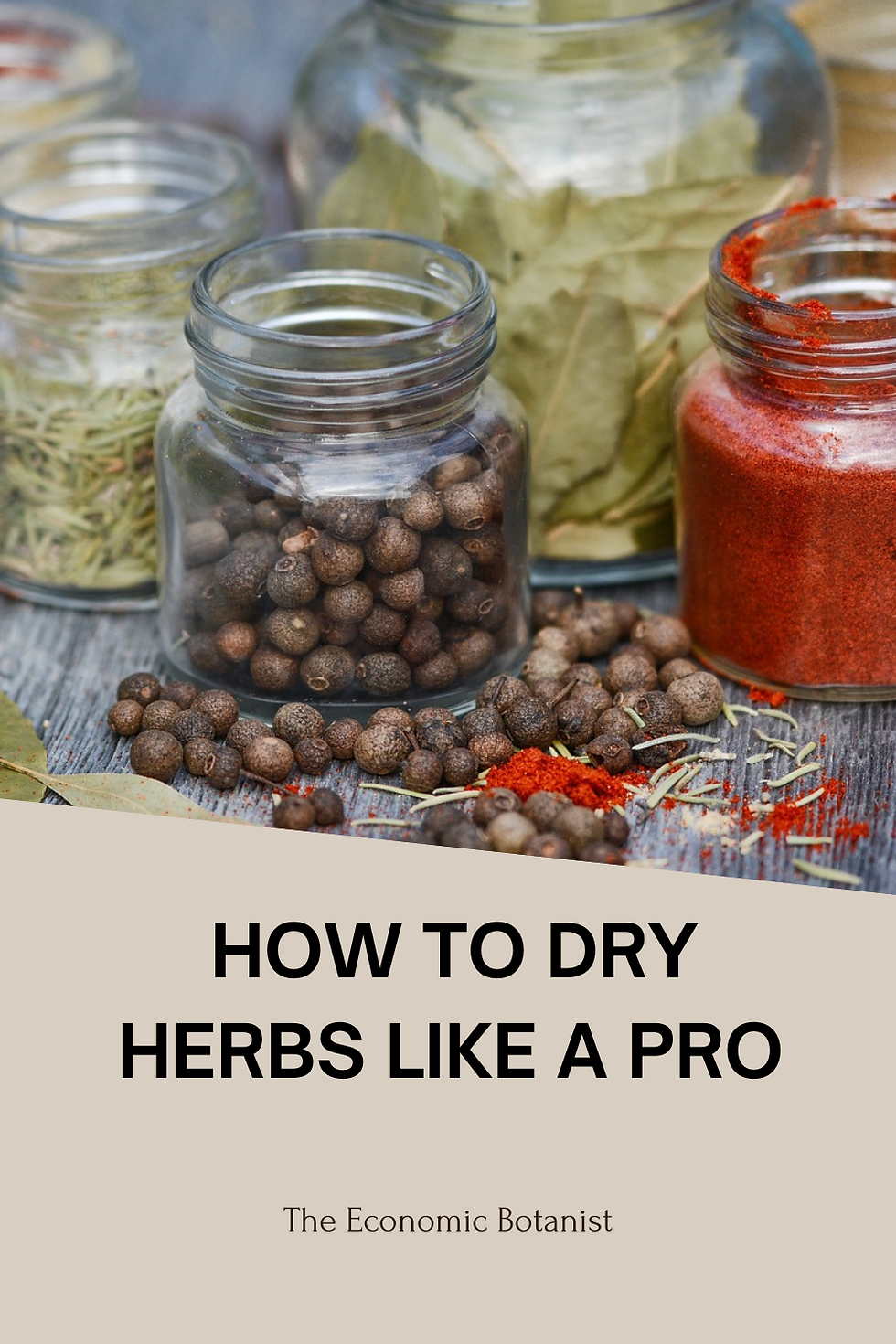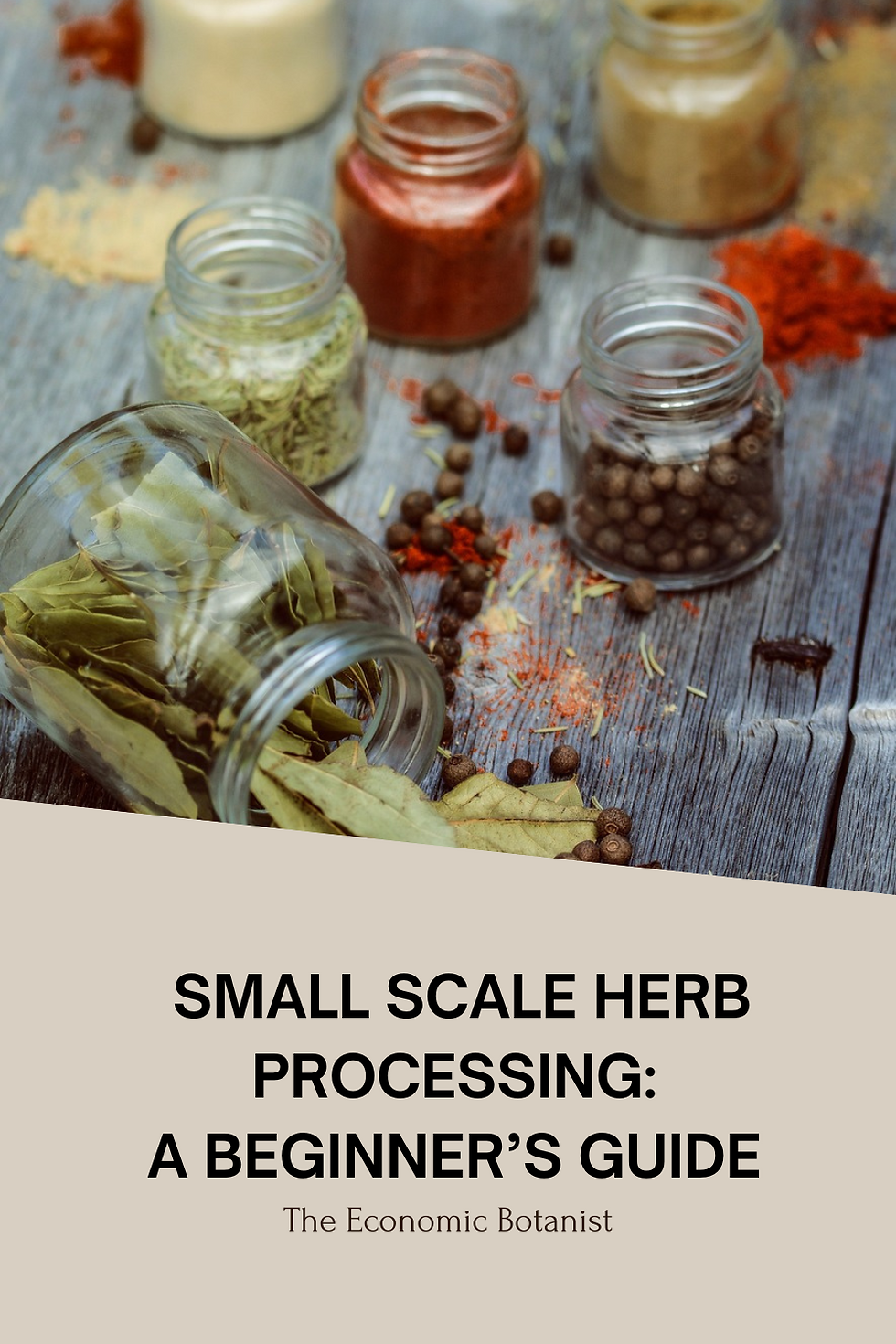How to Process and Market Herbs After Harvest: A Step-by-Step Guide for Growers
- The Economic Botanist

- Aug 3
- 7 min read
This article is about how you can take your fresh herbs from the garden to the market with confidence and care. It’s about turning those green leaves into valuable products that your customers will love.

“Great herbal products don’t just happen to be; they’re carefully cared for from harvest to market.” – The Economic Botanist
You might be familiar with herbs as tasty additions to your meals or soothing ingredients in teas. But what if we told you that how you handle those herbs after harvesting can make or break their flavor, aroma, and even their healing power? Yep — processing and marketing herbs isn’t just about packing leaves in a bag; it’s a whole science and art that helps you get the most out of your hard work.
This article dives into the key steps you need to know after harvesting your herbs—how to clean them right, the best ways to dry and store them, and smart packaging and marketing strategies that help your herbs stand out in the market. If you’re growing herbs for your kitchen, local sales, or even building a business, stick with me. You’ll learn practical tips backed by science to keep your herbs fresh, potent, and profitable.
Understanding Herb Processing: Why It Matters
Processing your herbs after harvest isn’t just a chore—it’s the key to making sure your herbs stay fresh, flavorful, and valuable. When we talk about herb processing, we mean everything that happens once you’ve picked the herbs: cleaning, drying, storing, and preparing them for sale.
If you skip or rush this step, your herbs can lose their flavor, color, or medicinal properties. For example, leaving herbs wet or packed too tightly can cause mold, ruining your batch. On the other hand, well-processed herbs hold their quality and bring you better prices.
Also, think about how you want to sell your herbs. Fresh herbs have a short shelf life, so you’ll need fast sales or local markets. But dried herbs open up a bigger window of time and more marketing options. This is where knowing fresh vs dried herbs selling helps you decide the best path for your herb business.
One simple tip here: always start with how to clean herbs properly. Removing dirt, insects, or damaged leaves early protects your product quality.
Harvesting Herbs: Best Practices
You probably already know harvesting herbs at the right time makes a huge difference. But did you know the time of day matters? Most growers pick herbs in the morning, after the dew dries but before the sun gets too hot. That’s when the oils that give herbs their flavor and aroma are at their peak.
Here are some quick pointers for your harvest:
Use sharp scissors or garden shears to avoid bruising the plant.
Pick just before flowering, unless you want the flowers for culinary or medicinal uses.
Handle your herbs gently to avoid crushing the leaves.
Avoid harvesting wet herbs, as moisture speeds up spoilage.
Right after you harvest, quickly move your herbs to a cool, shaded area for the initial post harvest herb processing steps. This slows wilting and helps you keep the best quality for drying or packaging.
Drying Herbs: Methods and Tips
Drying is the most popular and effective way to preserve herbs after harvest. When done well, it locks in the flavors, aromas, and medicinal benefits. There are several herb drying methods, and choosing the right one depends on your scale and resources.
Common Herb Drying Methods:
Air Drying: The traditional way. Bundle small bunches and hang them upside down in a dry, dark, well-ventilated space. This method works best for sturdy herbs like rosemary, thyme, and oregano.
Dehydrator Drying: Using an electric dehydrator is quick and controlled. Set the temperature between 95-115°F (35-46°C) to protect delicate oils. This is great for those wanting a faster, more consistent drying process.
Oven Drying: A backup method if you don’t have a dehydrator. Use the lowest heat setting and keep the oven door slightly open to allow moisture out. Watch closely to avoid burning.
Fun Fact Did you know some herbs, like basil, lose up to 90% of their essential oils if dried improperly? That’s why drying technique is so important! |
How to Dry Herbs Effectively:
Clean herbs thoroughly before drying.
Remove leaves from tough stems if desired.
Spread herbs in a single layer or hang them loosely for airflow.
Check herbs daily. They’re dry when leaves crumble easily between your fingers.
Avoid direct sunlight—it fades herbs and damages oils.
If you’re wondering about the best way to dry herbs, air drying is low-cost but slower, dehydrators speed things up and keep quality consistent, and oven drying is best only for emergencies or small batches.
Storing Herbs After Harvest
Once your herbs are dried, the next step is storing herbs after harvest to keep their quality for as long as possible. Proper storage prevents moisture, light, and air from degrading your herbs.
Here’s what you need to know:
Store dried herbs in airtight containers like glass jars with tight lids.
Keep containers in a cool, dark place—avoid sunlight and heat.
Avoid plastic bags for long-term storage because they don’t protect well against air and moisture.
Label your containers with the herb name and drying date to keep track.
Fresh herbs need refrigeration and quick use, ideally within a few days. For dried herbs, proper storage can extend shelf life up to a year or more.
Remember, herbs stored improperly can lose potency or develop mold. So, taking time with storage is crucial if you want to succeed with your herb business.
Packaging Herbs for Sale
Packaging is more than just putting herbs in a bag. It’s your chance to show quality, protect your product, and build your brand. When packaging herbs for sale, think about your customers and how you want your herbs to be used.
Packaging Tips:
Use moisture-proof, airtight packaging to keep dried herbs fresh. Mylar bags, glass jars, or sealed plastic containers work well.
For fresh herbs, breathable packaging like perforated bags or clamshell containers help avoid moisture buildup.
Don’t forget labeling herbal products! Include herb name, harvest or drying date, weight, and any organic or quality certifications.
Create a clean, professional look that matches your brand. You can add usage tips or recipes on the label to engage customers.
Consider creating value-added herb products like herb blends, teas, or infused oils. These often command higher prices and help diversify your offerings.
Marketing Herbal Products Successfully
Marketing your herbs is where you turn quality products into sales. Whether you’re selling at the farmer’s market, online, or to local retailers, a good herbal marketing strategy will help you stand out.
Know Your Market:
Are you targeting cooks, herbalists, or health-conscious buyers?
What problems do your herbs solve for them? Culinary flavor? Natural remedies?
Selling Channels:
Selling herbs online opens a big market but requires good photos and descriptions.
Farmer’s markets offer direct interaction—great for storytelling and building relationships.
Wholesale can mean bigger orders but lower prices.
Tips to Market Successfully:
Use social media to share your story, growing process, and tips on using herbs.
Create simple, helpful content like blog posts or videos about how to dry herbs or recipes.
Build a brand that reflects your values: organic, sustainable, local, etc.
Don’t forget to collect customer reviews and testimonials—they build trust.
Selling and Distribution Tips for Herb Growers
When you start selling herbs, you’ll find different routes to market. Each has its pros and cons.
Direct to Consumer (DTC): Farmers markets, online shops, or CSA boxes. You keep full retail price and build customer loyalty but handle all sales and marketing yourself.
Wholesale Herb Market: Selling bulk dried herbs or fresh herbs to retailers or manufacturers. This means bigger volumes but lower margins and less control over pricing.
Price competitively by researching local and online market prices for similar herbs.
Network with local chefs, herbalists, and shops to open doors for wholesale or consignment sales.
Starting and Growing Your Herb Business
If you want to take your herb growing to the next level, you need to think about setting up proper small scale herb processing operations.
Fun Fact The global herbal products market is expected to grow over 8% annually, showing how many people are turning to herbs for health and flavor. |
Essentials to Start:
Basic tools: scissors, drying racks or dehydrator, airtight containers.
A clean, dedicated space for drying and packaging.
Proper labeling and record-keeping for compliance with local regulations.
Learning about organic certifications or health department rules if you want to sell commercially.
Growing Your Business:
Invest in better equipment as you grow (commercial dehydrators, packaging machines).
Explore medicinal herb marketing if you grow herbs like chamomile or echinacea.
Constantly seek customer feedback and improve your product and marketing.
The Bottom Line
Processing and marketing herbs after harvest might seem like a lot, but with the right steps, you can protect your hard work and turn your herbs into a profitable product. From the moment you harvest, through drying, storing, packaging, and selling, each stage matters for quality and success. Remember to keep your customers in mind, tell your story, and build trust with good products and marketing.
If you start small and learn as you go, you’ll find herb growing and selling can be a rewarding adventure—one that connects you with nature and your community.
********************
Ready to take your herbs to the next level? Sign up for our newsletter to get more tips on growing, processing, and selling herbs. Let’s grow together!
Science ReadingA review of drying methods for improving the quality of dried herbs: This article provides an overview of different technological strategies developed for improving the quality of aromatic herbs for their industrial drying. Access this paper here Consumer Perception and Demand for Sustainable Herbal Medicine Products and Market: This article discusses consumer perception and demand for sustainable herbal medicine products (HMPs) by assessing the level of consumer awareness and knowledge as well as factors influencing consumer demand and perceptions about the efficacy and safety. Explore this article here Consumer Trends in the Herbal Tea Market: This article highlights how global integration influences local cultures and health awareness, while reflecting social and environmental concerns. It also discusses potential health hazards from herbal tea use, such as severe reaction to pollutant. Access this article here |







Comments